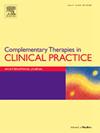Exploring the associations of perceived physical literacy with depression, anxiety, and stress among Spanish adolescents
IF 2.2
3区 医学
Q2 INTEGRATIVE & COMPLEMENTARY MEDICINE
引用次数: 0
Abstract
Background and purpose
The concept of physical literacy has gained prominence in the context of adolescent health, with increasing evidence suggesting its potential as a pivotal factor in promoting adolescent well-being and physical activity. The objective of the current study was to examine the relationships between perceived physical literacy (PPL) and symptoms of depression, anxiety, and stress in Spanish adolescents.
Materials and methods
A cross-sectional study including 714 adolescents was conducted. The Spanish Perceived Physical Literacy Instrument for Adolescents (S-PPLI) and Depression Anxiety Stress Scale 21 (DASS-21) were used. To determine the relationship between the PPL and DASS-21 score, robust linear regression models were constructed.
Results
After adjusting for several covariates, an inverse relationship was found between the S-PPLI score and the domains of the DASS-21 (symptoms of depression: unstandardized beta coefficient [B] = −0.14; 95 % confidence interval [CI] −0.20 to −0.08; p < 0.001; anxiety: B = −0.09; 95 % CI −0.15 to −0.04; p = 0.002; and stress: B = −0.09; 95 % CI −0.16 to −0.03; p = 0.006). Furthermore, adolescents with high PPL status presented significantly lower symptoms of depression, anxiety and stress than adolescents with low PPL status did.
Conclusion
PPL could be considered a key factor in preventing the development of symptoms of depression, anxiety, and stress in the adolescent population. Physical literacy might play a decisive role in the potential of physical activity in promoting mental health in adolescents.
探索西班牙青少年身体素养与抑郁、焦虑和压力的关系。
背景和目的:身体素养的概念在青少年健康的背景下得到了突出的地位,越来越多的证据表明,它可能是促进青少年福祉和身体活动的关键因素。本研究的目的是研究西班牙青少年感知身体素养(PPL)与抑郁、焦虑和压力症状之间的关系。材料与方法:对714名青少年进行横断面研究。采用西班牙青少年感知身体素养量表(S-PPLI)和抑郁焦虑压力量表21 (DASS-21)。为了确定PPL与DASS-21评分之间的关系,我们构建了稳健的线性回归模型。结果:在调整多个协变量后,发现S-PPLI得分与DASS-21的域呈负相关(抑郁症状:未标准化β系数[B] = -0.14;95%置信区间[CI] -0.20 ~ -0.08;结论:PPL可被认为是预防青少年抑郁、焦虑和压力症状发展的关键因素。体育素养可能在体育活动促进青少年心理健康的潜力中发挥决定性作用。
本文章由计算机程序翻译,如有差异,请以英文原文为准。
求助全文
约1分钟内获得全文
求助全文
来源期刊

Complementary Therapies in Clinical Practice
INTEGRATIVE & COMPLEMENTARY MEDICINE-
CiteScore
6.30
自引率
6.70%
发文量
157
审稿时长
40 days
期刊介绍:
Complementary Therapies in Clinical Practice is an internationally refereed journal published to meet the broad ranging needs of the healthcare profession in the effective and professional integration of complementary therapies within clinical practice.
Complementary Therapies in Clinical Practice aims to provide rigorous peer reviewed papers addressing research, implementation of complementary therapies (CTs) in the clinical setting, legal and ethical concerns, evaluative accounts of therapy in practice, philosophical analysis of emergent social trends in CTs, excellence in clinical judgement, best practice, problem management, therapy information, policy development and management of change in order to promote safe and efficacious clinical practice.
Complementary Therapies in Clinical Practice welcomes and considers accounts of reflective practice.
 求助内容:
求助内容: 应助结果提醒方式:
应助结果提醒方式:


